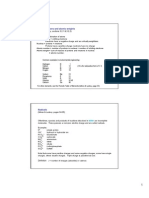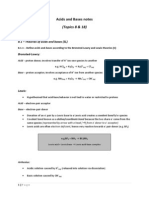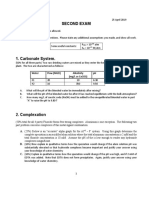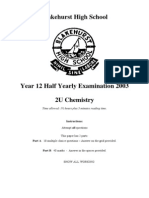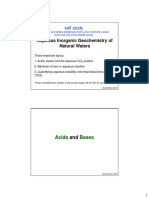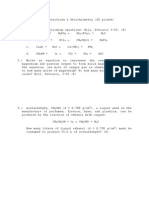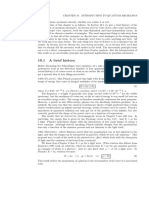0 ratings0% found this document useful (0 votes)
52 viewsChem 301: 2004MT1
Chem 301: 2004MT1
Uploaded by
AmirKazemianThis document contains a 5 question midterm exam for a chemistry 301 course. The questions cover topics like:
1) The differences between alkalinity and basicity, properties of water from hydrogen bonding, and why CO2 is more soluble in water than predicted by Henry's Law.
2) What makes water "hard" and the visible effects of boiling hard water.
3) Which ligand atoms are most likely to bind with Cd2+ and Ca2+ ions, and why.
The exam provides various chemical equations and equilibrium constants that may be useful for solving the problems.
Copyright:
© All Rights Reserved
Available Formats
Download as PDF, TXT or read online from Scribd
Chem 301: 2004MT1
Chem 301: 2004MT1
Uploaded by
AmirKazemian0 ratings0% found this document useful (0 votes)
52 views2 pagesThis document contains a 5 question midterm exam for a chemistry 301 course. The questions cover topics like:
1) The differences between alkalinity and basicity, properties of water from hydrogen bonding, and why CO2 is more soluble in water than predicted by Henry's Law.
2) What makes water "hard" and the visible effects of boiling hard water.
3) Which ligand atoms are most likely to bind with Cd2+ and Ca2+ ions, and why.
The exam provides various chemical equations and equilibrium constants that may be useful for solving the problems.
Original Description:
This document is for UBC Chem 301 course. It is for one of the previous midterms.
Original Title
CHEM 301: 2004MT1
Copyright
© © All Rights Reserved
Available Formats
PDF, TXT or read online from Scribd
Share this document
Did you find this document useful?
Is this content inappropriate?
This document contains a 5 question midterm exam for a chemistry 301 course. The questions cover topics like:
1) The differences between alkalinity and basicity, properties of water from hydrogen bonding, and why CO2 is more soluble in water than predicted by Henry's Law.
2) What makes water "hard" and the visible effects of boiling hard water.
3) Which ligand atoms are most likely to bind with Cd2+ and Ca2+ ions, and why.
The exam provides various chemical equations and equilibrium constants that may be useful for solving the problems.
Copyright:
© All Rights Reserved
Available Formats
Download as PDF, TXT or read online from Scribd
Download as pdf or txt
0 ratings0% found this document useful (0 votes)
52 views2 pagesChem 301: 2004MT1
Chem 301: 2004MT1
Uploaded by
AmirKazemianThis document contains a 5 question midterm exam for a chemistry 301 course. The questions cover topics like:
1) The differences between alkalinity and basicity, properties of water from hydrogen bonding, and why CO2 is more soluble in water than predicted by Henry's Law.
2) What makes water "hard" and the visible effects of boiling hard water.
3) Which ligand atoms are most likely to bind with Cd2+ and Ca2+ ions, and why.
The exam provides various chemical equations and equilibrium constants that may be useful for solving the problems.
Copyright:
© All Rights Reserved
Available Formats
Download as PDF, TXT or read online from Scribd
Download as pdf or txt
You are on page 1of 2
Chemistry 301 - MIDTERM EXAM #1
Wednesday, October 6, 2004, 9:00 am
Explain your answers whenever possible, Calculators are permitted.
Worth 20 points (20% of course)
1) (3 points) Briefly answer the following:
a) What is the difference between alkalinity and basicity?
b) Briefly describe two properties of water that are a unique consequence of cooperative
hydrogen bonding.
c) Why is CO
2
more soluble in water than you would predict based on Henry's Law alone?
2) (3 points) What does it mean when we say that water is "hard"? What visible effects are
found when hard water is boiled? Why? What is this due to?
3) (4 points) Given a choice of typical, naturally occurring ligand atoms (list them), which do
you think is/are the most likely candidates for Cd
+2
and Ca
+2
, respectively, to bind with?
Explain why.
4) (4 points) At pH 7.3, what is the dominant form of total CO
2
(CO
2
)? What is the ratio of
[HCO
3
-
] to [CO
3
-2
]? If CO
2
is measured to be 2.1 x 10
-3
M, what is [CO
3
-2
]?
5) (6 points) What is the predicted Mn
+2
concentration in equilibrium with MnCO
3
(s) at pH
8.0, in a solution with a carbonate alkalinity of 1.0 x 10
-3
eq./L?
Potentially useful data:
Reaction
Kind of
Constant
Value
CO
2
(aq) HCO
3
-
+ H
+
pK
a1
6.35
HCO
3
-
CO
3
-2
+ H
+
pK
a2
10.33
CO
2
(g) CO
2
(aq) pK
H
1.47
H
2
S(g) H
2
S(aq) pK
H
0.99
H
2
S(aq) HS
-
+ H
+
pK
a1
7.02
HS
-
S
-2
+ H
+
pK
a2
13.9
H
3
PO
4
H
2
PO
4
-
+ H
+
pK
a1
2.17
H
2
PO
4
-
HPO
4
-2
+ H
+
pK
a2
7.21
HPO
4
-2
PO
4
-3
+ H
+
pK
a3
12.32
Fe(OH)
3(s)
+ 3H
+
Fe
+3
+ 3H
2
O pK
sp
-3.96
Fe(OH)
2(s)
+ 2H
+
Fe
+2
+ 2H
2
O pK
sp
-12.9
Pb(OH)
2
(s) Pb
+2
+ 2OH
-
pK
sp
19.79
PbCO
3
(s) Pb
+2
+ CO
3
-2
pK
sp
12.82
CaCO
3
(s) Ca
+2
+ CO
3
-2
pK
sp
8.35
MnCO
3
(s) Mn
+2
+ CO
3
-2
pK
sp
9.3
AlPO
4
(s) Al
+3
+ PO
4
-3
pK
sp
21.0
Al
+3
+ OH
-
Al(OH)
+2
pK
f1
-9.0
Al
+3
+ 2OH
-
Al(OH)
2
+
p
f2
-18.7
Al
+3
+ 3OH
-
Al(OH)
3(s)
p
f3
-27.0
Al
+3
+ 4OH
-
Al(OH)
4
-
p
f4
-33.0
H
3
(NTA) H
+
+ H
2
(NTA)
-
pK
a1
1.66
H
2
(NTA)
-
H
+
+ H(NTA)
-2
pK
a2
2.95
H(NTA)
-2
H
+
+ (NTA)
-3
pK
a3
10.28
Ca
+2
+ (NTA)
-3
Ca(NTA)
-
pK
f
-8.2
Mn
+2
+ (NTA)
-3
Mn(NTA)
-
pK
f
-8.7
Fe
+2
+ (NTA)
-3
Fe(NTA)
-
pK
f
-9.6
Pb
+2
+ (NTA)
-3
Pb(NTA)
-
pK
f
-11.4
Al
+3
+ (NTA)
-3
Al(NTA) pK
f
-13.4
Fe
+3
+ (NTA)
-3
Fe(NTA) pK
f
-17.9
For the reaction: aA + bB cC + dD,
K = [C]
c
[D]
d
at equilibrium, Q = [C]
c
[D]
d
at any given moment
_______ _______
[A]
a
[B]
b
[A]
a
[B]
b
Henrys Law: [X
(aq)
] = K
H
P
X
[X
(aq)
] = concentration of gas X in water
K
H
= Henrys Law constant at specific T,P,S
P
X
= partial pressure of gas X in solution at equilibrium
You might also like
- Cellular Respiration LabDocument3 pagesCellular Respiration LabKelvin Liao0% (1)
- HT11 ReportDocument20 pagesHT11 ReportTing Kee ChuongNo ratings yet
- Safety Data Sheet Hyprox (TM) 400-600 Hydrogen Peroxide (Us-Ghs Haz)Document20 pagesSafety Data Sheet Hyprox (TM) 400-600 Hydrogen Peroxide (Us-Ghs Haz)Renaldo MoontriNo ratings yet
- Chemistry 301 - M E #1: Explain Your Answers Whenever Possible, Calculators Are PermittedDocument4 pagesChemistry 301 - M E #1: Explain Your Answers Whenever Possible, Calculators Are PermittedJohn DunlapNo ratings yet
- Basic-Chemical-Concepts PDFDocument9 pagesBasic-Chemical-Concepts PDFAbdelhaleem KhaderNo ratings yet
- Lecture 8: Ocean Carbonate Chemistry: Carbonate ReactionsDocument36 pagesLecture 8: Ocean Carbonate Chemistry: Carbonate ReactionsShripadagouda GoudappagoudarNo ratings yet
- 12e1 PDFDocument5 pages12e1 PDFwastequestNo ratings yet
- Chemistry 101 SPRING 2010: Exam 2 Form D Section 503 Dr. Keeney-KennicuttDocument9 pagesChemistry 101 SPRING 2010: Exam 2 Form D Section 503 Dr. Keeney-KennicuttAgung RiyantoNo ratings yet
- Problem Set 7 SolutionDocument5 pagesProblem Set 7 SolutionRod De GuzmanNo ratings yet
- Paper No.: Mechanism of CO Corrosion of Mild Steel: A New NarrativeDocument16 pagesPaper No.: Mechanism of CO Corrosion of Mild Steel: A New NarrativeCN CinematographyNo ratings yet
- Print Version: Lecture #20 Closed Systems II & AlkalinityDocument19 pagesPrint Version: Lecture #20 Closed Systems II & AlkalinityNermeen ElmelegaeNo ratings yet
- MS Xi ChemistryDocument5 pagesMS Xi ChemistryMayankNo ratings yet
- Lecture 7a - Redox Process and Equilibrium K23Document36 pagesLecture 7a - Redox Process and Equilibrium K23Hải MinhNo ratings yet
- Chem 1040 Final Exam ReviewDocument8 pagesChem 1040 Final Exam ReviewUzair AliNo ratings yet
- 16.E Acid Base Equilibria Exercises Chemistry LibreTexts PDFDocument2 pages16.E Acid Base Equilibria Exercises Chemistry LibreTexts PDFgarciacLoNo ratings yet
- AIPMT 2015 Sample PaperDocument26 pagesAIPMT 2015 Sample PaperFirdosh Khan100% (3)
- Acids and Bases NotesDocument15 pagesAcids and Bases Notescgao30No ratings yet
- Chemistry Practise QuestionDocument12 pagesChemistry Practise Questiong24n3950No ratings yet
- Chemistry Form 6 Semester 2Document121 pagesChemistry Form 6 Semester 2Thivyaapriya SambamoorthyNo ratings yet
- Chemistry November 2008 Paper 3Document17 pagesChemistry November 2008 Paper 3wb4qv7yzvzNo ratings yet
- 1001ch PDocument41 pages1001ch P50calpotatoNo ratings yet
- Chemistry Question Banks AyDocument67 pagesChemistry Question Banks AyOni AyomideNo ratings yet
- Ionic Equlibrium NEET QuestionsDocument18 pagesIonic Equlibrium NEET Questionsneeteshrawatkvs7851No ratings yet
- 08-09 Practice 2nd Trimester ExamDocument9 pages08-09 Practice 2nd Trimester ExamEmily LeeNo ratings yet
- Exam 2 Review PDFDocument8 pagesExam 2 Review PDFkyle javierNo ratings yet
- Chemistry Form 6 Sem 2 02Document121 pagesChemistry Form 6 Sem 2 02Sharon RamaiahNo ratings yet
- 11th gulf board question paper pdfDocument4 pages11th gulf board question paper pdfdedass.footbath265No ratings yet
- Practice Form 2 Sample ExamsDocument15 pagesPractice Form 2 Sample ExamsKevin NdanyiNo ratings yet
- Assign 1 2016 SolutionsDocument17 pagesAssign 1 2016 SolutionsIkhsan RifqiNo ratings yet
- ch12 Odd PDFDocument37 pagesch12 Odd PDFmecsolNo ratings yet
- CHEM 301 Assignment #1Document17 pagesCHEM 301 Assignment #1san toryuNo ratings yet
- Wa0010.Document32 pagesWa0010.Tanvi GuptaNo ratings yet
- 19e2 PDFDocument9 pages19e2 PDFwastequestNo ratings yet
- 19e2 PDFDocument9 pages19e2 PDFwastequestNo ratings yet
- Chemistry Final ExamDocument4 pagesChemistry Final ExamIpshita pathakNo ratings yet
- Bimbel 2Document6 pagesBimbel 2Wibowo Sugandi, S.T.No ratings yet
- Lab Assignment - Template Yr 2022 - Exp 2Document8 pagesLab Assignment - Template Yr 2022 - Exp 2Lim Kuan YuNo ratings yet
- 2003 Blakehurst High School Chemistry Half Yearly ExamDocument9 pages2003 Blakehurst High School Chemistry Half Yearly ExamJay LiNo ratings yet
- JEE Main Chemistry Previous Year Questions With Solutions On EquilibriumDocument5 pagesJEE Main Chemistry Previous Year Questions With Solutions On EquilibriumConimicNo ratings yet
- CH 03 Study GuideDocument7 pagesCH 03 Study GuideivankcurryNo ratings yet
- General Chemistry 1 - Final Exam 2013Document2 pagesGeneral Chemistry 1 - Final Exam 2013hjlouis2004No ratings yet
- Aqueous Inorganic Geochemistry of Natural Waters: Self StudyDocument24 pagesAqueous Inorganic Geochemistry of Natural Waters: Self StudyNguyen tiendungNo ratings yet
- Che1031 Lecture 4 ExamplesDocument11 pagesChe1031 Lecture 4 ExamplesThem Mendoza Dela CruzNo ratings yet
- EstequimoetriaDocument26 pagesEstequimoetriazammantha.calderongNo ratings yet
- Icch 210 Practice Final ExamDocument8 pagesIcch 210 Practice Final ExamNayoon Kim100% (1)
- Sci Oly Practice QuestionsDocument5 pagesSci Oly Practice QuestionsJessica JimenezNo ratings yet
- Chemical Equilibrium Problem Set # 1 Mmxv.1: 2 3 2 3 2-3 + C + 3 3 2 + C + 2 2+ C/P 3 3 2 C/P 3 2 4 2 2 7 C/PDocument1 pageChemical Equilibrium Problem Set # 1 Mmxv.1: 2 3 2 3 2-3 + C + 3 3 2 + C + 2 2+ C/P 3 3 2 C/P 3 2 4 2 2 7 C/PMs. B100% (2)
- Nanyang Technological University Singapore Entrance Examination CHEMISTRY (Sample) InstructionsDocument8 pagesNanyang Technological University Singapore Entrance Examination CHEMISTRY (Sample) InstructionsAriny Lastarya PutriNo ratings yet
- Inorganic Chemistry Acids & Bases: Pauling'sDocument6 pagesInorganic Chemistry Acids & Bases: Pauling'sAlmasriJosephNo ratings yet
- Equilibrium PQ 2025Document2 pagesEquilibrium PQ 2025kmsharma322007No ratings yet
- Chemistry For Engineers: Assignment 1Document4 pagesChemistry For Engineers: Assignment 1Thanh Tan PhamNo ratings yet
- Inorganic Chemistry Problem SetsDocument6 pagesInorganic Chemistry Problem Setsarejay castroNo ratings yet
- 2nd Set Air-Water-Soil InteractionDocument53 pages2nd Set Air-Water-Soil InteractionShrilalraghudevNo ratings yet
- CHEM 101 Past Questions With Answers by TihboiDocument10 pagesCHEM 101 Past Questions With Answers by TihboiDhar MieNo ratings yet
- Worksheet 10 AnswersDocument5 pagesWorksheet 10 AnswersRohmah MileniaNo ratings yet
- Merination NotesDocument34 pagesMerination NotesNarmadha RameshNo ratings yet
- Ranjeet ShahiDocument11 pagesRanjeet Shahisabhari_ram50% (2)
- Chemistry 2016Document16 pagesChemistry 2016milapdhruvcomputerworkNo ratings yet
- Exam Try Inor - PrintDocument6 pagesExam Try Inor - PrintHà Thế VinhNo ratings yet
- 11th Chemistry Model PaperDocument13 pages11th Chemistry Model Papersasi.curieNo ratings yet
- Aieee 2009 PaperDocument20 pagesAieee 2009 PaperBhanu Pratap RathoreNo ratings yet
- Practice Makes Perfect in Chemistry: Oxidation-ReductionFrom EverandPractice Makes Perfect in Chemistry: Oxidation-ReductionRating: 5 out of 5 stars5/5 (1)
- 2.A Look Behind The Salt CurveDocument4 pages2.A Look Behind The Salt CurveAndres MadridNo ratings yet
- Thermoelectric EffectDocument5 pagesThermoelectric EffectUday KhanalNo ratings yet
- Qaunatu MajnerDocument10 pagesQaunatu MajnerPepilloNo ratings yet
- O LVL Chemistry Bendemeer Prelim 2018Document48 pagesO LVL Chemistry Bendemeer Prelim 2018randomvidsNo ratings yet
- MSE - Group 1 - Metals and Metal AlloysDocument12 pagesMSE - Group 1 - Metals and Metal AlloysRenz Allen AbataNo ratings yet
- Algebra Word Problems DDocument2 pagesAlgebra Word Problems DrandonamNo ratings yet
- Physics Notes Chapter - Atom & NucleiDocument2 pagesPhysics Notes Chapter - Atom & NucleiAvantika YadavNo ratings yet
- Analysis of Horoscope Through The Ashtakavarga TableDocument2 pagesAnalysis of Horoscope Through The Ashtakavarga TableHoracio Tackanoo0% (1)
- 8 - Solidification of Weld MetalDocument23 pages8 - Solidification of Weld MetalbassemNo ratings yet
- Innovize Capabilities 16038290605063870Document15 pagesInnovize Capabilities 16038290605063870Walfran BonillaNo ratings yet
- Sikadur 55 LP inDocument3 pagesSikadur 55 LP inRUDRA KARMAKARNo ratings yet
- Simulation of Rapid Depressurization and PDFDocument13 pagesSimulation of Rapid Depressurization and PDFhoangvubui4632100% (1)
- (SG111) Sealxpert 111 Silicone Grease - Rev 1Document1 page(SG111) Sealxpert 111 Silicone Grease - Rev 1Khoon Fen KBNo ratings yet
- Science X Case Study Question 01Document10 pagesScience X Case Study Question 01Bhawana Singh100% (2)
- Assignment-08 WEP Physics Yakeen 2.0 (2024) MR SirDocument5 pagesAssignment-08 WEP Physics Yakeen 2.0 (2024) MR Sircoolakshat3664No ratings yet
- Analysis of Sun Path and Effective Shading Co-Efficient Using ECOTECT Software For CoimbatoreDocument11 pagesAnalysis of Sun Path and Effective Shading Co-Efficient Using ECOTECT Software For CoimbatoreHiren H DoshiNo ratings yet
- Instructions For Dytex Solvent Cement Jointing of PVC-U and PVC-C Dimension d12 To d140Document3 pagesInstructions For Dytex Solvent Cement Jointing of PVC-U and PVC-C Dimension d12 To d140TUAN ANHNo ratings yet
- General Structural Features - Properties of PolymersDocument9 pagesGeneral Structural Features - Properties of PolymersOsho AryanNo ratings yet
- Polymers Why Is Rubber ElasticDocument14 pagesPolymers Why Is Rubber ElasticreddyNo ratings yet
- Spices and Condiments - CHEMICAL TESTINGDocument46 pagesSpices and Condiments - CHEMICAL TESTINGsunil Barsiwal100% (1)
- York V MSDSDocument3 pagesYork V MSDSSteven simadjajaNo ratings yet
- ETP Water Analysis ReportDocument1 pageETP Water Analysis ReportDebashish Roy0% (1)
- VG0-Pap - (ASCE) - Shear Behaviour of Joints in Segmental BridgesDocument22 pagesVG0-Pap - (ASCE) - Shear Behaviour of Joints in Segmental BridgesPATHA ADITHSAINo ratings yet
- Presented By:: Mr. Akshay M. Akotkar B - Pharm IV TH YrDocument12 pagesPresented By:: Mr. Akshay M. Akotkar B - Pharm IV TH YrRafael PontesNo ratings yet
- Proceedings of 10th International Conference On Recent Advances in Civil AviationDocument452 pagesProceedings of 10th International Conference On Recent Advances in Civil AviationLê Hoàng MaiNo ratings yet
- Ocr 33981 PP 09 Jan L Gce 2813 03Document8 pagesOcr 33981 PP 09 Jan L Gce 2813 03Philip_830No ratings yet




